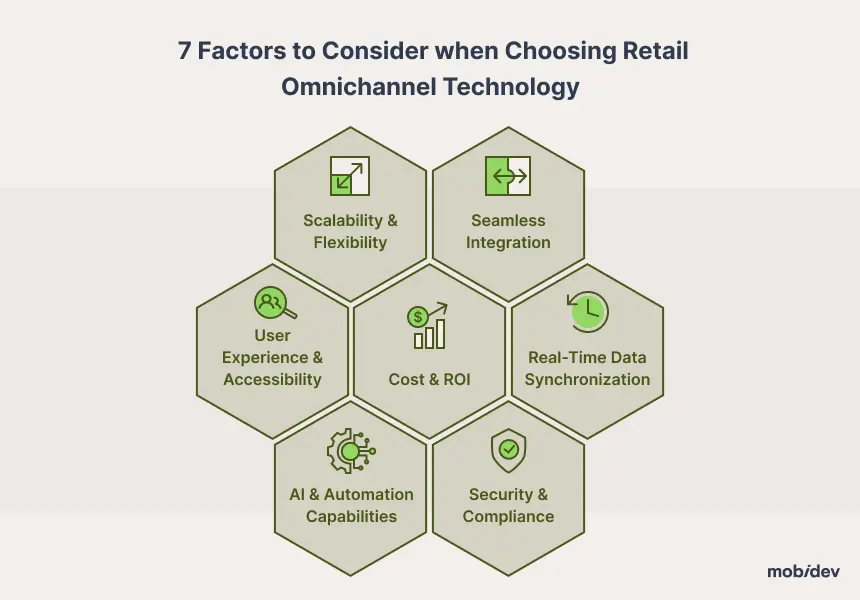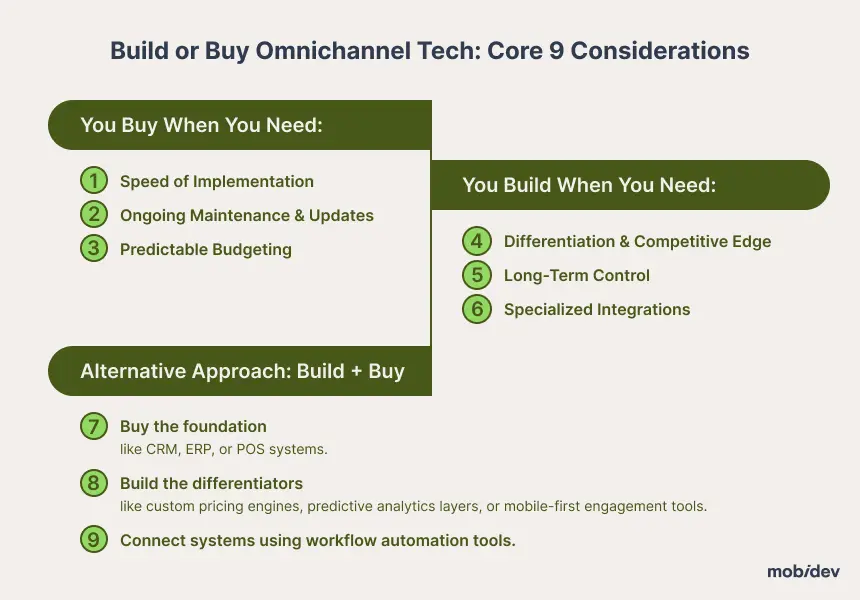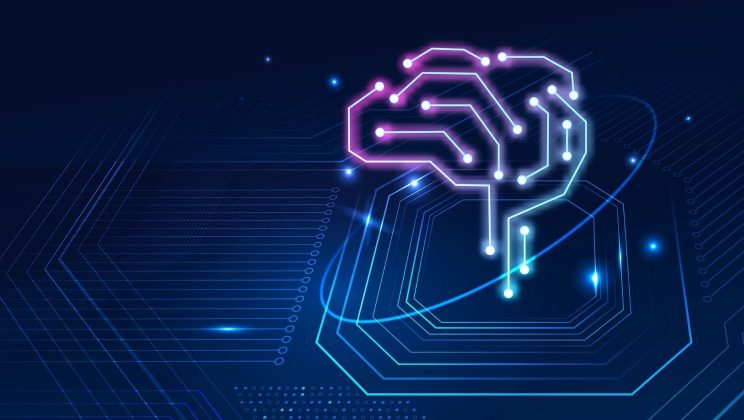Omnichannel retail has become a business imperative. Today’s customers expect a seamless experience, whether they’re browsing a website, using an app, or walking into a store. For large retailers, especially those still running on legacy systems, meeting that expectation takes more than just vision. It requires the right tech foundation.
There are so many moving parts, like POS software, CRM, inventory management software, mobile apps, etc. So, it’s hard to know where to start, what to prioritize, and how to make it all play nicely together.
That’s what this guide is for.
It’s built with retail leaders in mind: CEOs, CTOs, and product teams leading the charge toward true omnichannel experiences.
The guide is just as relevant for Retail SaaS companies, too. If you want to build tools that solve the real problems of your clients, you need a clear view of what those problems look like on the ground.
Over the past few years, performing the role of a Solution Architect at MobiDev, I’ve worked closely with companies modernizing outdated systems and rolling out future-ready solutions. Along the way, my team and I have learned what works, what breaks, and where the real value lies.
Recently, our team at MobiDev has been focusing on building fault-tolerant, scalable, and high-performance systems for retail. I’ve summarized my experience and expertise in this guide. You will find our obtained experience and knowledge useful to optimize your retail technology or launch innovative, market-ready products.
Let’s dive in.
Omnichannel: The New Era of Retail Business
According to a 2017 study by Harvard Business Review, almost 73% of customers wanted an omnichannel experience when researching a future purchase — a trend that remains highly relevant today as Salesforce reports. There’s no doubt your brand should be easy to find wherever people are.
Omnichannel retail is all about creating a consistent shopping experience across every touchpoint when a customer is browsing online, using an app, or walking into a store. It goes beyond simple multichannel strategies, which just offer multiple ways to engage.
The key difference is that omnichannel connects those channels, so the customer journey feels smooth and uninterrupted.
The 4 Core Elements of Omnichannel Retail
To successfully implement an omnichannel retail strategy, multiple customer touchpoints are not enough. Retailers need deep integration and alignment across systems, processes, and data.
Here are the four core elements that make omnichannel actually work:
1. Seamless Online and Offline Integration
Customers think in terms of convenience, not channels. When they browse online, then go to a physical store, then look for items on mobile, the experience is expected to be smooth and connected.
This requires tight integration between operations in digital platforms and brick-and-mortar stores.
2. Real-Time Inventory Management
It’s essential to have accurate, up-to-date inventory data across all locations and channels. If you don’t, customers may have difficulties finding the right item, and staff will struggle with helping them (but you can’t blame them, as the system doesn’t work properly).
Real-time inventory systems enable smarter fulfillment options, reduce overstock and stockouts, and build trust with customers by automatically offering what the latter may need.
3. Unified Customer Data and Personalization
You can only achieve real personalization when all aspects of customers’ behavior and purchase habits are tracked (anonymously, of course). More than that, you need all the data collection points to be available to all channels.
With that in mind, a unified customer data system is a backend-supported, interconnected machine that works from any touchpoint.
4. Efficient Fulfillment and Logistics
When all of the customer data is gathered and stored for access by multiple channels, you can get efficient services like ship-from-store, same-day delivery, or in-store pickup. Only with the automation of data processing do you get a system that can demolish logistics obstacles and make it all work.
In addition, customers expect a straightforward return process, the lack of which may lead to dissatisfaction and lower brand trust. Omnichannel makes the return process simpler, so you can increase your brand trust and loyalty. With the right connection between all of your channels, it’s easy to measure.
How Omnichannel Retail Works
Omnichannel retail really works when every part of the customer journey is connected, no matter where or how someone shops.
Say someone finds a product on Instagram and clicks through to your website. They add it to their cart but decide to visit a nearby store to check it out in person. When they walk in, the sales associate already knows what they’re looking for and makes a suggestion. And if their size isn’t in stock? No stress; it gets shipped to their doorstep.
That’s the kind of experience people remember and come back for.
One of the key things here is real-time inventory visibility. Instead of using a bunch of spreadsheets, store teams can instantly check stock across multiple locations.
Another essential layer is unified customer data. Only when a customer’s history and preferences are available across all channels can you offer truly personalized experiences. Think customized promotions, targeted rewards, and service that feels more personalized and less transactional.
For retail teams, this unified data layer also means informed decision-making. Store managers can track performance trends across regions, better understand customer behavior, and respond more quickly to changes in demand.
In short, omnichannel retail works by connecting the dots between people, systems, and locations. So you meet customers where they are, deliver better service, and operate with more agility.
How to Build an Effective Retail Omnichannel Strategy: 5 Steps to Follow
A seamless omnichannel experience never happens by chance. It works when you have a clear, well-planned strategy that aligns technology, operations, and customer experience in a single system.
The goal is to create a connected retail ecosystem where data flows freely, touchpoints work in sync, and every employee at some level contributes to delivering a consistent experience.
1. Defining Clear Business Goals
Before diving into implementation, ask yourself: Are you aiming to increase in-store conversions? Improve customer loyalty? Reduce operational costs?
Omnichannel initiatives should be tied directly to measurable business goals. From revenue growth to enhanced customer satisfaction to internal process efficiency. When goals are clearly defined and aligned across departments, it gets easier to prioritize features and resources while keeping ROI at bay.
2. Creating a Unified Customer Journey
Just because you’re on every platform doesn’t mean you’re doing omnichannel right. Omnichannel retail isn’t about being everywhere but rather about showing up in the right places in the right way. Just where your customers expect you.
To get there, you need to understand how your shoppers move between touchpoints. Where do they start? Where do they get stuck? What makes them drop off?
3. Breaking Down Data Silos
One of the biggest barriers to making a successful omnichannel retail is fragmented data. When customer, inventory, and operational insights aren’t tied together, it’s impossible to gain a nice 360-degree view of how you’re doing. It results in data silos and disconnection between channels.
Usually, a centralized data strategy is built around a single customer data platform (CDP). It can help in collecting the right analytics and making sure data is associated with the same instances across all departments.
4. Ensuring Cross-Departmental Collaboration
Tech is not all that makes omnichannel work. You need people who are interested in making it happen. Marketing, IT, operations, customer service —all of them should be united and interested in optimizing the omnichannel paradigm.
Luckily, there’s already a sync between those teams (e.g., marketing relies on customer service to understand customer behavior). You should invest in this synergy and help your teams realize that turning omnichannel will help them get their jobs done with less hassle.
5. Investing in Technology
While strategy sets the direction, technology makes omnichannel possible.
The right technology stack is the glue that can mend customer data and create the analytics machine that works for the benefit of omnichannel retail instead of managing data for the sake of managing data.
In the next section, we’ll dive into the technologies that power successful omnichannel retail and talk about how to choose the right ones. This is where things get really interesting.
Choosing the Right Technology Stack for Omnichannel Retail
Sure enough, technology is the backbone of any successful omnichannel strategy. But for large retailers, especially those working with legacy infrastructure, choosing the right tools can be a tough nut to crack.
This section helps clarify what to look for in a powerful retail tech stack and why those choices matter.
Why Technology is Critical for Omnichannel Success
There’s a lot of data that each channel operates with. To deliver a truly frictionless customer experience across locations and devices, retailers need more than just individual tools. They need an integrated, intelligent system.
Outdated legacy systems and siloed data create major roadblocks. They make it hard to track inventory in real-time, personalize customer interactions, or fulfill orders efficiently — in general, to create a smooth experience for customers and employees.
Modern technologies, like cloud computing, AI, API, or event-driven platforms, allow retailers to unify operations and respond to customer behavior at the right moment. For example, AI demand forecasting can serve as a means to predict what products you need and in which locations.
Without the right foundation in place, retailers risk falling behind and losing ground to competitors who are faster, more data-driven, and better at meeting customer expectations.
NRF expects retail sales to grow by 2.7-3.7% in 2025, so you want to get as much of this pie slice as possible.
The Key 7 Factors for Retailers When Choosing Omnichannel Technology
Choosing the right technology is not about finding isolated tools that work well. It’s more about selecting tools that speak to each other the best. There are some features that you need to pay attention to.
1. Scalability & Flexibility
Your systems should be able to grow with your business, support new locations and regions, and add workflows without requiring constant rework or costly customizations.
API-first platforms are a great choice here as they allow you to expand functionality as your needs evolve. Gradually. In addition to that, you can use cloud technologies to further improve scalability.
Make sure you build your solution with seasonal surges, multi-region support, and new integrations in mind.
2. Seamless Integration
Technology should plug into your current POS, ERP, CRM, and internal platforms with minimal friction. The goal is interoperability, not another data silo.
Build systems with open APIs, standardized data formats, and proven integration support so you don’t waste time or budget on fragile connectors or manual workarounds.
3. Real-Time Data Synchronization
Every part of your business, from the sales floor to the back office, should operate with the same real-time data on inventory, pricing, and customer activity. Otherwise, you risk losing money and customers on unexpected turns.
Ensure that the solution you create includes streaming data pipelines or event-driven architecture, especially for handling high transaction volumes.
4. Security & Compliance
No omnichannel or its efficiency matters if your and your customers’ data is unprotected.
Your systems must meet global and local standards for privacy, fraud prevention, and regulatory compliance (e.g., GDPR, CCPA, PCI-DSS).
Make sure platforms provide role-based access control, encryption at rest, in transit, and in use, audit logs, and regular third-party security testing. Don’t underestimate how much compliance readiness can speed up procurement and avoid risks later.
Also, remember to check how each tool you’re using handles data storage and security. The risk of omnichannel is that even one breach can lead to the entire system being put at risk. Also, having multiple channels readily available significantly increases the attack surface.
5. AI & Automation Capabilities
From demand forecasting to staff scheduling and inventory replenishment, AI agents for retail help reduce costs and improve accuracy.
Build platforms with embedded machine learning capabilities or the ability to integrate your own models.
For customer-facing tools, personalization engines can drive loyalty and increase basket size when fueled by unified customer data. The key is to focus on automation that actually simplifies operations, rather than adding complexity.
6. User Experience & Accessibility
Whether it’s a store associate using a handheld device or a manager analyzing performance dashboards, systems should be intuitive, responsive, and easy to use.
Develop a system with a clean UI, mobile-optimized interfaces, and accessibility features, like multilingual support and offline mode. A poor user experience leads to low adoption rates and training overhead, especially in high-turnover retail environments.
7. Cost & ROI
Don’t just consider upfront costs. Evaluate the total cost of ownership, including licensing, integration, support, and training, and how the solution supports long-term ROI.
You should have a system that includes a reduction in manual effort, improved inventory turnover, fewer lost sales, and faster time-to-market for new initiatives.
It sometimes makes sense to simply purchase this kind of platform. But, if you want a future-proof and complex system, custom-built is the preferred option.
For Retailers: Omnichannel Technology Solutions — Buy or Build?
For omnichannel retailers, the “build vs. buy” question isn’t just about building or buying a software solution, it’s about strategy.
And the right answer? It depends. On your timeline, your internal capabilities, your ambitions, and your appetite for complexity and flexibility.
Here’s how to think about it.
Core 5 Considerations
Before you make your decision, weigh these factors carefully. Each one can significantly shift the equation.
1. Time to Market
If speed is a top priority, buying is the fastest route to launch.
Shopify Plus, Salesforce Commerce Cloud, and Microsoft Dynamics 365 all come with pre-built integrations. Those platforms make great use of best practices and launch timelines that can be measured easily.
This makes them ideal for retailers who need to move fast to meet market demand or competitive pressure.
2. Customization Needs
Got complex business logic? Niche workflows? Hyper-specific user journeys? Off-the-shelf platforms may fall short.
In these cases, building gives you the freedom to tailor every piece of the experience, whether it’s configuring pricing rules by region or designing an entirely new type of checkout flow.
The tradeoff: higher cost, longer timelines, and a heavier lift from your tech team. To address these challenges, use custom retail software development.
3. Scalability
Enterprise-grade SaaS platforms, like SAP or Oracle, offer industrial-strength scalability out of the box.
But, if your business model demands elastic, modular scaling (say, spinning up new microservices to handle regional pricing or AI-powered inventory routing), custom, cloud-native builds may give you more headroom and agility.
4. Integration with Legacy Systems
If your tech stack already includes homegrown systems or industry-specific software, building may actually simplify things.
Custom development lets you design for cleaner integration, avoiding the pain of retrofitting pre-packaged platforms into a bespoke architecture.
5. Upfront vs Long-Term Costs
Buying tends to come with a lower upfront cost, but recurring fees and limited flexibility can eat into ROI over time.
Building gives you control and long-term cost efficiency, especially if you need deep customization. But remember to keep the cost of development, QA, DevOps, and support in mind.
When to Buy
Here are the scenarios where buying wins, hands down.
1. Speed of Implementation
Need to launch a new D2C channel in 90 days? Off-the-shelf tools are built for fast deployment and scalability. You get proven functionality with minimal lift, so you can test markets, capture demand, and iterate faster.
2. Proven Reliability
Established platforms have already weathered scaling issues, bugs, and edge cases. They come with extensive support networks, knowledge bases, and global uptime guarantees, so your team isn’t firefighting code during peak season.
3. Ongoing Maintenance & Updates
Security patches, compliance updates, feature rollouts — they’re all handled by the vendor. That means less operational drag on your internal team and more bandwidth for innovation elsewhere.
4. Predictable Budgeting
SaaS subscriptions offer consistent, predictable pricing structures. This makes it easier to plan for growth, align with finance teams, and avoid surprises that derail roadmaps.
When to Build
Sometimes, only custom-built tech will do.
1. Differentiation & Competitive Edge
If your customer experience is your secret weapon, building may be your best bet. Whether it’s in-store personalization powered by AI, a bespoke loyalty program, or a completely reimagined post-purchase journey, owning your stack means you can push the envelope.
2. Long-Term Control
When you build, you own the roadmap. You decide what features get prioritized, when updates roll out, and how your tech evolves alongside your business.
This is critical for future-proofing and avoiding vendor lock-in.
3. Specialized Integration
Need deep omnichannel integration with proprietary systems or third-party platforms your competitors don’t use? Building gives you the connective tissue you need. In the best case scenario, it’s designed from day one to talk to everything you already run.
Hybrid Approach: Build + Buy
In reality, most modern retailers don’t pick a side, they blend both.
- Buy the foundation. CRM, ERP, and POS systems are great candidates for proven, scalable platforms.
- Build the differentiators. Custom pricing engines, predictive analytics layers, or mobile-first engagement tools can all be developed in-house or with partners.
- Connect systems using workflow automation tools.
For example, you can run on Salesforce Commerce Cloud for core commerce and use React Native to develop high-performance retail mobile apps. This way, you balance speed with flexibility. It’s ideal for retailers looking to innovate without reinventing the wheel.
8 Challenges in Implementing Omnichannel Technology for Large Retail Brands
Building a seamless omnichannel ecosystem isn’t just about choosing the right tech stack. Navigating the complex realities of legacy infrastructure, siloed data, shifting consumer expectations, and internal resistance to change — all those are challenges to consider.
For large retail brands, implementation at scale is rarely plug-and-play. It’s a multi-dimensional transformation.
Here’s where it often gets hard and why.
1. Dealing with Data Silos
The Problem:
Retailers often operate with fragmented systems (separate databases for in-store sales, e-commerce, CRM, and supply chain). The result? Data lives in silos, making it nearly impossible to deliver a truly connected experience.
Key Challenges:
- Customer behavior and purchase history are disconnected across touchpoints, limiting personalization.
- Inventory discrepancies arise due to unaligned systems, leading to stockouts or delays.
- Generating a 360-degree customer view becomes a manual, error-prone, or outright unachievable task.
Why It Matters:
True omnichannel is built on unified, real-time data. Without it, every customer interaction risks being misinformed. That’s why breaking down data silos is one of the key challenges you should keep in mind when implementing omnichannel retail.
2. Integrating Legacy Systems with Modern Solutions
The Problem:
Legacy systems, like your old POS, ERP, or inventory management software, weren’t built for the kind of seamless experience omnichannel demands. And if you’re a large company, completely replacing them isn’t exactly a quick or easy fix. It’s expensive, time-consuming, and risky.
That’s why so many retailers feel stuck. You want to go omnichannel. You see the value. But your tech just isn’t built for it, and overhauling everything overnight isn’t realistic. The challenge arises in finding ways to bridge the gap, integrating what you already have with the modern tools and platforms your customers expect.
Key Challenges:
- Upgrading or replacing core systems is often expensive, complex, and risky.
- Internal teams may resist change, especially if there are deeply embedded workflows that work “fine”.
- Migrations can cause operational disruptions or data loss if not carefully planned.
Why It Matters:
Omnichannel success hinges on system interoperability. Without integration, even the best new tools can’t fully deliver.

Learn deeper:
Full Guide on Application Modernization3. Ensuring Real-Time Data Synchronization
The Problem:
In omnichannel commerce, if data doesn’t sync instantly across channels, the customer experience suffers, and so does operational efficiency.
Key Challenges:
- Inventory shown online may be inaccurate, leading to overselling or order cancellations.
- Pricing discrepancies between platforms erode customer trust.
- Fulfillment delays due to lagging updates disrupt logistics and support.
Why It Matters:
Speed and accuracy in data syncing aren’t just technical wins, they directly impact conversions, loyalty, and margins.
4. Managing Security, Compliance, & Data Privacy
The Problem:
Omnichannel increases the number of customer touchpoints. And with it, the attack surface. In addition to regulatory obligations and cyber threats, brands must protect customer trust while meeting legal mandates.
Key Challenges:
- Navigating complex regulations like GDPR, CCPA, and PCI DSS across geographies
- Mitigating cyber threats that target centralized data and cross-channel authentication
- Maintaining secure identity management across mobile, web, and in-store systems
Why It Matters:
Failure to secure omnichannel systems doesn’t just mean fines, it risks brand reputation damage and customer trust.
5. Scaling Infrastructure for High Traffic & Demand Surges
The Problem:
Omnichannel platforms must perform under pressure, whether it’s Black Friday traffic or a viral campaign. Without scalable infrastructure, retailers risk outages when it matters most.
Key Challenges:
- Ensuring commerce and mobile platforms stay fast and stable during peak periods
- Managing backend throughput for real-time transactions and analytics
- Avoiding vendor bottlenecks when relying on third-party infrastructure.
Why It Matters:
Scalability isn’t just about uptime. Customers need to be confident that their experience is taken care of. Fail once, and they may not ever come back.
6. Employee Training & Change Management
The Problem:
Even the most advanced system will fail if frontline teams don’t know how (or don’t want) to use it. People, not just platforms, determine implementation success.
Key Challenges:
- Resistance from employees used to legacy tools and workflows
- Intensive training needs across POS, inventory, support, and fulfillment systems
- Risk of operational disruption during the transition period.
Why It Matters:
Technology adoption depends on team buy-in and enablement. Without it, transformation efforts stall.
7. Cost of Implementation & ROI Visibility
The Problem:
Omnichannel investments — AI, cloud platforms, integration layers — are expensive. But justifying that spend can be tough, especially in the early phases.
Key Challenges:
- Balancing capital expenditure with long-term benefits
- Difficulty measuring ROI on customer experience and operational efficiency
- Ongoing costs of maintenance, integrations, and vendor lock-in.
Why It Matters:
Retailers need a clear business case and strong internal alignment to secure and sustain investment in omnichannel tech.
8. Omnichannel Logistics & Fulfillment Complexity
The Problem:
Delivering on modern consumer expectations — BOPIS, same-day delivery, flexible returns — requires more than just logistics. It demands deep operational alignment and intelligent systems.
Key Challenges:
- Smart inventory allocation between warehouses, stores, and third-party providers
- Optimizing last-mile delivery without eating into margins
- Streamlining reverse logistics to reduce return friction and restocking costs.
Why It Matters:
Logistics are now part of the customer experience. Omnichannel fulfillment can either elevate or erode it.
How MobiDev Can Help You with Omnichannel Tech Stack
MobiDev has proven experience in helping both retail SaaS providers and direct-to-consumer brands build and scale omnichannel technology solutions. You can benefit from our deep expertise in retail software development and AI consulting. So your business can:
- Modernize outdated systems by integrating legacy platforms with modern infrastructure.
- Build custom solutions tailored to your business model, workflows, and customer journey.
- Scale confidently with architecture designed for flexibility, performance, and long-term growth.
Explore our retail software development services to see how we’ve helped dozens of retail companies and SaaS providers implement solutions across POS, CRM, ERP, inventory management, and customer experience platforms.
You may also want to elevate your omnichannel experience with artificial intelligence. In this case, use our AI consulting services to leverage machine learning for demand forecasting, fulfillment optimization, and operational automation with AI agents.
You can turn your data into powerful business outcomes as we help you create strategic AI roadmaps and custom model development and deployment.
Let’s build something remarkable together!







